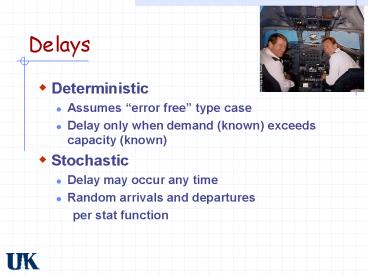Delays - PowerPoint PPT Presentation
1 / 16
Title: Delays
1
Delays
- Deterministic
- Assumes error free type case
- Delay only when demand (known) exceeds capacity
(known) - Stochastic
- Delay may occur any time
- Random arrivals and departures
- per stat function
2
Deterministic Delay
3
Delay Estimation (1/2)
Greatest Delay
Total Delayed Aircraft
Greatest Queue
Runway Capacity
Delay Period
Delay Period
4
Delay Estimation (2/2)
- Area
- A/C-Hours of delay
- Demand-Capacity
D-C
Time
5
Example (1/2)
End hour Operations Capacity D-C Cumul.
7 25 30 -5 0
8 30 30 0 0
9 40 30 10 10
10 50 30 20 30
11 45 30 15 45
12 15 30 -15 30
13 10 30 -20 10
14 15 30 -15 0
15 20 30 -10 0
6
Example (2/2)
Area under the curve ½110½(1030)1½(304
0)1 ½(4030)1 ½(3010)1½101120 AC-hr
Avg Delay to All AC 120/250 28.8 min/AC
Avg Delay to Delayed 120/(405045151015)
41.1 min/AC
7
Stochastic Delay
- Queuing theory concepts
- Probability function
- Arrival rate
- Service time
- Required data
- Arrival pattern
- Service pattern
- Service method
- Queue discipline
- Number of servers
8
Delay Equations (random/poisson arrivals, uniform
service dist means variance 0)
- See p. 304
- To use for HW prob 16, must compute average
hourly demand (blows up if demandgtsupply) - part c should more properly be worded increased
to 8 minutes, not limited to 8 minutes.
9
Mathematical Formulation of Delay
10
M/D/1 Queuing Model
11
M/D/1 Queuing Model
- q -- Arrival (or departure) rate ?
- Q -- Service rate (utilization) ??
- Average waiting time in queue
12
M/D/1 Equations
- Average Time in System (hours)
- Average Queue Length (number)
- Average Time in service (hours)
13
M/M/1 Queuing Models
- M -- Exponentially distributed arrival and
departure times and one departure channel
(server, e.g., runway) - 1 One runway
- q Arrival (or departure) rate
- Q -- Service rate
- From statistics recall
- Exponential distribution
14
M/M/1 Queuing Models
- Average waiting time in queue
- Average time in system
- Average queue length
- Probability of k units in system
- P(k) (q/Q)k 1-(q/Q)
15
Example (note different terminology)
(1/2)
End hour Operations Capacity D-C Cumul.
7 25 30 -5 0
8 30 30 0 0
9 40 30 10 10
10 50 30 20 30
11 45 30 15 45
12 15 30 -15 30
13 10 30 -20 10
14 15 30 -15 0
15 20 30 -10 0
- Arrival rate
- q 250/9 27.8 A-C/hr
- Service rate
- Q 30 A-C/hr
- Use M/M/1 model
16
Example (2/2)
- Average wait time
- E(w)q/Q(Q-q)27.8/30(30-27.8) 0.42 hr/A-C
- Average queue length
- E(m)q2/Q(Q-q)27.82/30(30-27.8) 11.7 A-C
- Probability of no plane in the system
- P(0) (q/Q)01-(q/Q) 0.073
- Probability of one in the system (no line)
- P(1) (q/Q)11-(q/Q) 0.068
- Probability of two in the system (one in line)
- P(1) (q/Q)21-(q/Q) 0.063































